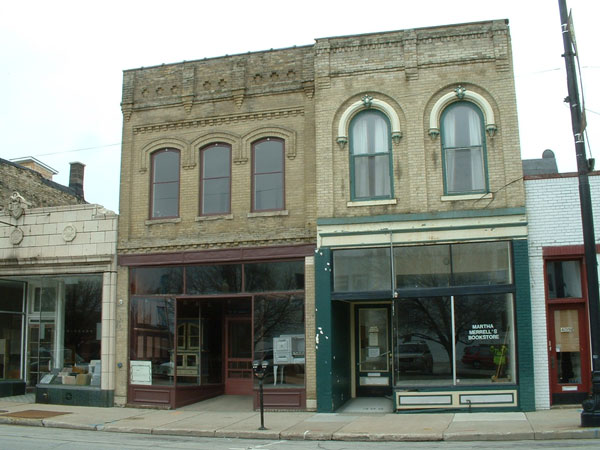Article and photos by Gregory Havel
Mercantile occupancies prefer to display their goods for sale to people passing by in the street. Before large panes of glass became available for shop windows, the proprietor would hang over the door a sign in the shape of the goods that he made or sold: a shoe for a shoemaker; a wheel or wagon cut-out for a carriage builder; a book for a bookseller; and so on.
When window glass became less expensive, the merchandise for sale was displayed in large windows facing the street. Since glass has little compressive strength, the weight of the wall and floors above is carried by a beam that spans the front of the store from side wall to side wall (Photo 1).

In early buildings, this beam was usually wood. In the late 1800s, this beam was often made of wrought iron. Since the early 1900s, this beam usually has been made of steel. This beam is usually concealed behind the exterior cladding of the building: brick, tile, stone, wood, or other material.
Photo 1 shows parts of four storefronts.
- In the buildings at the far left and far right, the beams over the plate glass storefronts support the masonry above, including the parapets above the entrances.
- In the two-story building at the left, the beam over the plate glass storefront supports the second-story front wall and the parapet with brick cornice above. The beam is enclosed by the band of sheet metal between the top of the plate glass and the bottom of the brick masonry.
- In the two-story building at the right, the beam over the plate glass storefront supports the second-story front wall and the parapet with brick cornice above. The beam is enclosed by the painted wood between the top of the plate glass and the bottom of the brick masonry.
Modern commercial construction is similar. For security, these buildings often have no windows except for those near the main entrance, which limits our options for ventilation. “Big box” stores are usually single-story, although their ceilings may be more than 30 feet (9.14 m) above the floor.
On our arrival, if the fire has self-vented or if firefighters remove the window glass for ventilation or fire attack, it is critical that we place a hoseline to protect and cool the beam above the main entrance and windows and that this hoseline and crew be placed outside the collapse zone. If we do not protect the beam supporting the structure, we set ourselves up for a significant structural collapse when the beam fails. A collapse zone must be set up early in the incident and enforced for our own safety.
For a more detailed discussion of this building feature, see Collapse of Burning Buildings by Vincent Dunn (Fire Engineering Books and Videos).
Download this article as a PDF HERE.
 Gregory Havel is a member of the Town of Burlington (WI) Fire Department; retired deputy chief and training officer; and a 30-year veteran of the fire service. He is a Wisconsin-certified fire instructor II, fire officer II, and fire inspector; an adjunct instructor in fire service programs at Gateway Technical College; and safety director for Scherrer Construction Co., Inc. Havel has a bachelor’s degree from St. Norbert College; has more than 30 years of experience in facilities management and building construction; and has presented classes at FDIC.
Gregory Havel is a member of the Town of Burlington (WI) Fire Department; retired deputy chief and training officer; and a 30-year veteran of the fire service. He is a Wisconsin-certified fire instructor II, fire officer II, and fire inspector; an adjunct instructor in fire service programs at Gateway Technical College; and safety director for Scherrer Construction Co., Inc. Havel has a bachelor’s degree from St. Norbert College; has more than 30 years of experience in facilities management and building construction; and has presented classes at FDIC.
MORE CONSTRUCTION CONCERNS

